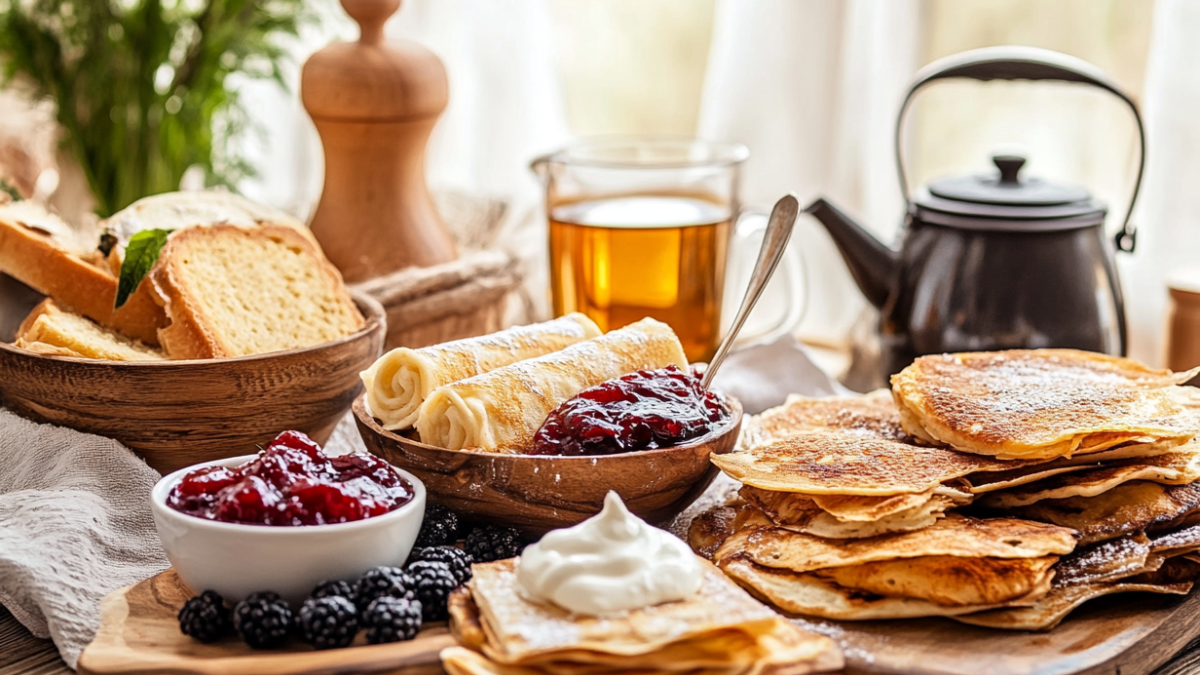Exploring Traditional Russian Breakfasts
Russian breakfasts offer a fascinating glimpse into the country’s rich culinary heritage. Hearty, simple, and packed with nutrients, these meals reflect Russia’s history, geography, and cultural traditions. From warming porridges to indulgent pastries, breakfast is not only the most important meal of the day in Russia but also a ritual that unites generations. In this article, we delve deep into the history, popular dishes, and evolving trends of Russian breakfasts, providing a complete guide to one of the most diverse morning cuisines in the world.
Historical Context of Russian Breakfasts
Breakfast in Russia has its roots in practicality and sustenance. Families prepared this meal to fuel a day of labor in fields, factories, or homes. Over centuries, Russian breakfasts evolved to reflect agricultural practices, religious traditions, and the country’s harsh climate.
Key Historical Influences
- Agriculture: Farmers used grains like buckwheat, rye, and millet because they were abundant and adaptable. These staples became the foundation of porridges and breads, which remain key breakfast components.
- Religion: Orthodox Christianity shaped meal compositions. During fasting periods, families relied on dairy-free and meat-free breakfasts like vegetable soups or bread with honey.
- Geography and Climate: Russia’s cold winters encouraged hearty, warming foods, making porridges and pancakes essential at breakfast tables.
Today, these traditions persist. Moreover, modern adaptations ensure that Russian breakfasts remain relevant and cherished. To explore other hearty breakfast traditions, try this Korean Bulgogi Chicken Recipe, which pairs well with rice for a wholesome meal.
Staple Ingredients in Russian Breakfasts
Russian breakfasts rely on simple yet versatile ingredients that are deeply rooted in the country’s culinary traditions. These staples form the base for a wide variety of dishes.
Grains and Cereals
- Buckwheat: Known as “grechka,” this gluten-free grain is essential for kasha and savory porridges.
- Semolina: Often cooked into creamy porridge, it is sweetened with sugar or fruit.
- Rye Flour: Used in baking traditional breads and pancakes.
Dairy Products
- Tvorog (Quark): A soft cheese central to many dishes, including syrniki and vatrushka.
- Sour Cream (Smetana): A tangy topping for pancakes, porridges, and savory foods.
- Butter and Milk: Essential for porridges and pastries.
Breads
- Rye Bread: Dense and hearty, served with butter, cheese, or jam.
- Blini and Oladyi: Pancakes made from wheat or rye flour, offering versatility in flavor.
Beverages
- Tea: Strong black tea remains a breakfast staple, often sweetened or served with lemon.
- Kefir: A probiotic-rich fermented milk drink, enjoyed alone or with bread.
- Coffee: Increasingly popular in urban areas.
For baked goods enthusiasts, these Old-Fashioned Dinner Rolls offer a taste of home-style comfort.
Popular Russian Breakfast Dishes
Kasha (Porridge)
Kasha is synonymous with Russian breakfasts. This versatile dish, made from grains like buckwheat, millet, or semolina, can be served sweet or savory.
Variations of Kasha
- Sweet Kasha: Flavored with butter, honey, or jam and topped with fresh fruits.
- Savory Kasha: Seasoned with salt and butter, often accompanied by sour cream.
Kasha is more than a meal; it represents warmth and sustenance. Furthermore, it is a cornerstone of Russian culinary heritage.
Cultural Significance
Russian households view kasha as a nostalgic dish connecting generations. For instance, many children enjoy it as one of their first solid foods.
Blini and Oladyi (Pancakes)
oladyi and Blini are iconic Russian breakfast staples, celebrated for their versatility.
Blini
- Thin, crepe-like pancakes rolled or folded around sweet or savory fillings.
- Popular fillings include jam, honey, sour cream, or caviar.
- Blini play a central role during Maslenitsa, a festival marking the end of winter.
Oladyi
- Thick, fluffy pancakes made with yeast or baking soda.
- Served with smetana, condensed milk, or berries.
These pancakes symbolize hospitality and celebration. Additionally, they offer endless customization options to suit personal preferences.
Unique Blini Recipes
Chefs now create colorful variations of blini by adding spinach, beet juice, or buckwheat flour, enhancing both nutrition and presentation. Consequently, these innovations appeal to a broader audience.
Syrniki (Cheese Pancakes)
Syrniki are soft pancakes made with tvorog, flour, and eggs. Lightly fried, they achieve a crispy exterior and a creamy interior.
How Syrniki Are Served
- Topped with honey, jam, or powdered sugar for sweetness.
- Paired with sour cream for a tangy contrast.
- Enhanced with raisins, dried fruits, or a hint of vanilla.
For a savory twist, enjoy syrniki with this Chicken Breakfast Sausage Recipe.
Buterbrody (Open-Faced Sandwiches)
Buterbrody, or open-faced sandwiches, are quick and satisfying. These consist of rye bread topped with butter and various ingredients.
Common Toppings
- Savory: Cheese, cold cuts, smoked fish, or caviar.
- Sweet: Butter paired with honey, jam, or fresh fruits.
Modern Twists
Modern buterbrody include ingredients like avocado, hummus, or gourmet cheeses, catering to evolving tastes. Consequently, they appeal to a wide range of preferences.
These sandwiches showcase Russian practicality and resourcefulness.
Vatrushka (Sweet Cheese Buns)
Vatrushka is a traditional pastry filled with sweetened tvorog. Its soft dough and tangy filling make it a breakfast favorite.
How Vatrushka Is Enjoyed
- Best served warm alongside a cup of tea.
- Often enjoyed as a mid-morning snack.
Regional Variations
In some regions, vatrushka includes vanilla, cinnamon, or citrus zest for unique flavors. As a result, the dish offers subtle yet delightful differences across the country.
Regional Variations in Russian Breakfast
Russia’s vast geography introduces regional differences in breakfast traditions. While staples like kasha and blini are universal, local ingredients inspire unique variations.
Coastal Regions
- Heavy use of seafood like smoked salmon, herring, and caviar.
- Rye bread with fish spreads is common.
Siberia
- Hearty porridges and soups dominate due to cold climates.
- Pelmeni (dumplings) occasionally feature as breakfast items.
Central Russia
- Known for baked goods like pirozhki and vatrushka.
- Dairy-based dishes like syrniki remain popular.
Regional Innovations
Siberian chefs now incorporate locally sourced berries, like sea buckthorn, into breakfast dishes, adding vibrant flavors. Therefore, regional breakfasts continue to evolve while honoring tradition.
Modern Influences on Russian Breakfast
Globalization has introduced new trends and flavors to Russian breakfast tables. While traditional dishes remain cherished, younger generations embrace modern alternatives.
International Trends
- Smoothies, avocado toast, and granola are now popular, especially in urban areas.
- Cafés serve French pastries, English breakfasts, and American-style pancakes.
Health and Wellness Movements
- Plant-based options like almond milk and vegan yogurt appear in traditional recipes.
- Low-carb and gluten-free versions of breads and porridges cater to health-conscious diners.
Hybrid Dishes
- Traditional foods like blini and kasha are reinvented with ingredients such as chia seeds, matcha, and quinoa.
Breakfast Bowls
Inspired by global trends, breakfast bowls layer kasha, yogurt, fruits, and nuts, appealing to health-conscious individuals. Consequently, these bowls provide both nutrition and aesthetic appeal.
Additional Insights into Russian Breakfast Culture
Breakfast in Russia is more than a meal; it fosters connection and tradition. Here are cultural nuances that make Russian breakfasts unique:
The Role of Family
Breakfast is often a time for family members to gather before starting their day. Sharing food and conversation strengthens bonds. Additionally, it sets a positive tone for the rest of the day.
Seasonal Variations
During summer, fresh berries and fruits enhance porridges and pastries. In contrast, winter breakfasts rely on preserved foods like jams and pickled vegetables.
Hospitality
Guests are often treated to hearty breakfasts as a gesture of hospitality. Warm blini or syrniki make visitors feel welcome. Furthermore, these dishes reflect the host’s care and effort.
FAQs About Russian Breakfast
What do Russian typically drink for breakfast?
Russians usually drink strong black tea, often sweetened or with lemon. Coffee is gaining popularity, and kefir remains a traditional choice.
Are Russian breakfast healthy?
Yes, Russian breakfast dishes often focus on whole grains, dairy, and fresh ingredients, providing a balanced start to the day.
Do Russians eat eggs for breakfast?
Eggs are less common but appear in omelets or as toppings for buterbrody. Check out this Crescent Roll Breakfast Recipe for an egg-inspired dish.
Is breakfast the main meal in Russia?
No, lunch is traditionally the largest meal. However, breakfast provides essential energy for the day.
What is a typical weekend breakfast in Russia?
Weekends feature leisurely breakfasts like blini, syrniki, or vatrushka. Families enjoy these together with tea or coffee.
Conclusion
Russian breakfast are more than just food—they reflect history, culture, and family values. From comforting kasha to delicate syrniki, these dishes provide a glimpse into Russia’s rich culinary heritage.
If you’re inspired to try diverse meals, consider this Balsamic Chicken Recipe. Let Russian breakfasts add warmth and tradition to your mornings.

